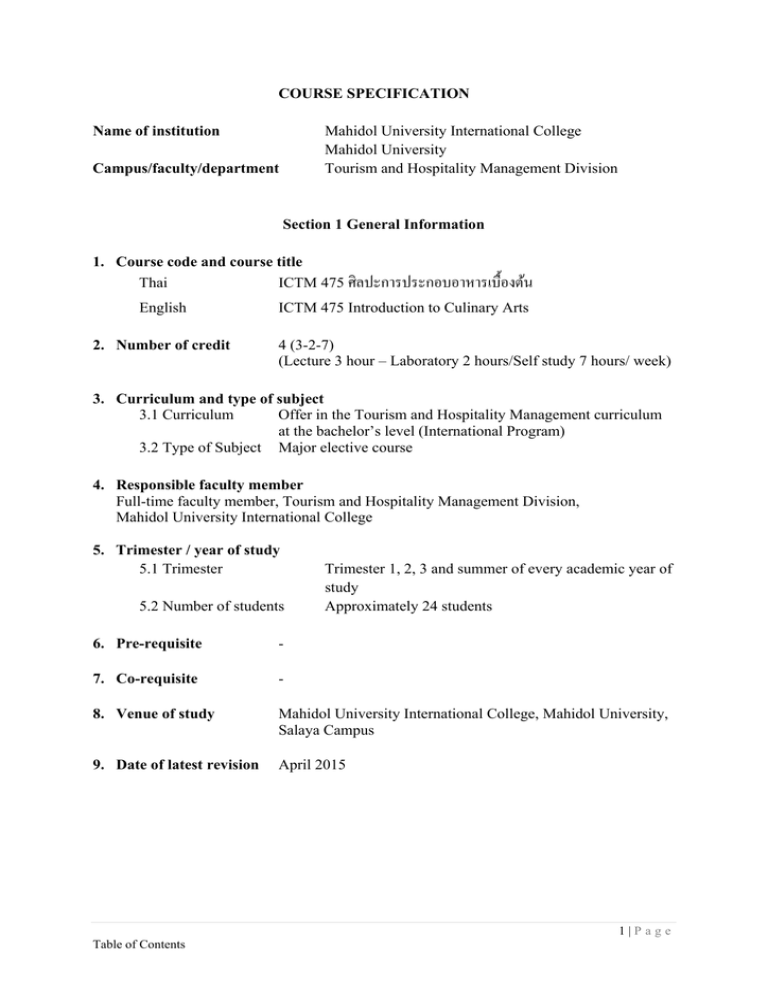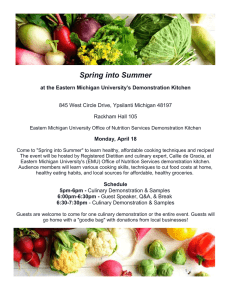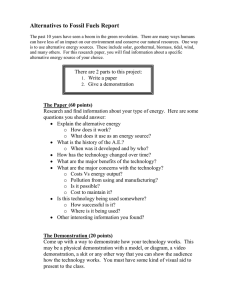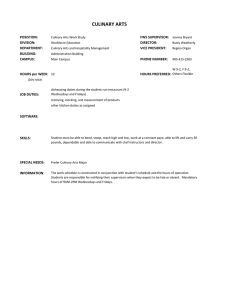
COURSE SPECIFICATION
Name of institution
Mahidol University International College
Mahidol University
Tourism and Hospitality Management Division
Campus/faculty/department
Section 1 General Information
1. Course code and course title
Thai
ICTM 475 ศิลปะการประกอบอาหารเบื้องต้น
English
2. Number of credit
ICTM 475 Introduction to Culinary Arts
4 (3-2-7)
(Lecture 3 hour – Laboratory 2 hours/Self study 7 hours/ week)
3. Curriculum and type of subject
3.1 Curriculum
Offer in the Tourism and Hospitality Management curriculum
at the bachelor’s level (International Program)
3.2 Type of Subject Major elective course
4. Responsible faculty member
Full-time faculty member, Tourism and Hospitality Management Division,
Mahidol University International College
5. Trimester / year of study
5.1 Trimester
5.2 Number of students
Trimester 1, 2, 3 and summer of every academic year of
study
Approximately 24 students
6. Pre-requisite
-
7. Co-requisite
-
8. Venue of study
Mahidol University International College, Mahidol University,
Salaya Campus
9. Date of latest revision
April 2015
1|Page
Table of Contents
Section 2 Goals and Objectives
1. Goals
After successful completion of the course students will be able to:
(1)Discuss the history of the food service industry and describe different categories of
food service units within the food service industry.
(2)Demonstrate good personal hygiene and safe food handling procedures.
(3)Describe causes of and prevention procedures for food-borne illness, intoxication and
infection.
(4)Identify the basic stocks, leading sauces, compound sauces, emulsion sauces and
independent sauces.
(5)Indentify, select, use and care for small and large food service equipment and use
hand tool safely and efficiently.
(6)Recognize standard knives, measuring devices, hand tool and cooking vessels.
(7)Properly weigh and measure common kitchen ingredients. Describe and utilize basic
culinary cooking techniques in the production of quality food products.
(8)Understand the importance of sanitation and inspection in the processing of meat.
(9)Describe a basic understanding of the most important organisms affecting the quality
of meat.
(10) Demonstrate proper safety practices in meat cutting.
(11) Demonstrate the procedure for purchasing, handling and storage various fresh and
frozen seafood.
(12) Define the terminology of vegetables, rice, grains and pasta and their recipes.
Indentify the components of an egg. Prepare a variety of eggs and breakfast menus.
(13) Demonstrate proper using of various thickening agents. Indentify and use
information on standardized recipes using abbreviations, equivalent measurement, and
mathematical operations and standard substitution. Analyze types, components and
classifications of the menu.
(14) Create appealing menu for each course.
(15) Research careers in the restaurant and food and beverage service industry, including
educational and work experience needs for success.
2. Objectives of development/revision
To revise course in order to be up-to-date and relevant to the current situation.
2|Page
Table of Contents
Section 3 Course Management
1. Course descriptions
วางแผนและปฏิบตั ิการประกอบการอาหารด้วยวิธีการหลากหลาย ทั้งในด้านการเตรี ยม การปรุ ง
วัตถุดิบต่างๆ รวมถึงความเข้าใจในความหมายของศัพท์ทางด้านอาหาร การอ่านและประเมินรายการอาหาร
พัฒนาตํารับอาหาร เรี ยนรู ้เทคนิคและการแปรค่าการชัง่ ตวง วัด วิธีการตั้งราคาอาหาร และการควบคุม
ต้นทุน การใช้และการถนอมอุปกรณ์เครื่ องมือในครัว พร้อมทั้งเทคนิคต่างๆในการให้บริ การ
Planning and operating food and beverage production in quantity food settings;
various methods of food preparation ingredients and culinary terminology; reading and
evaluating menus; developing recipe conversion and costing skills; examining different
production schemes and product flow; the use and care of equipment, service techniques,
procurement management, and cost control.
2. Credit hours / trimester
Lecture
Additional class
(Hour)
(Hour)
3 hours
-
Laboratory/field
trip/internship
(Hour)
2 hours
Self study
(Hour)
7 hours
3. Number of hours that the lecturer provides individual counseling and guidance
At students’ request within the working week (Mon-Fri).
3|Page
Table of Contents
Section 4 Development of Students’ Learning Outcome
1. Expected outcome on students’ skill and knowledge
Students will be able to apply the knowledge from lecturer and additional research with
the ideas received from analysis and synthesis to set up solutions/ precautions to benefit
individuals and their community
2. Teaching methods
Course organized using lecture, presentation and demonstration methods. Teaching
materials include documents and visual aids..
3.
Evaluation methods
1. Ethics and Morality
1.1 Expected outcomes on ethics and morality
(1) Have integrity and honesty, and ability to deal with conflicts between own
benefits, and morality and ethics
(2) Have a positive attitude toward the career, express morality and ethics toward
work, and treat others consistently
(3) Be responsible for own work, be a good member, and participate in leadership
development activities, and be a good role model for others
(4) Have a good discipline at work, and follow rules and regulations of organizations
and societies
1.2 Teaching methods
Learning Centered Education : Emphasis on knowledge development, important
skills in career development and living, encourage students to use their full potentials
(1) Lecture
(2) Case studies with past experiences and current events
(3) Emphasis on morality and ethics
(4) Group discussion
(5) Group assignment
1.3 Evaluation methods
(1) Written examination
(2) Presentation
(3) Class attendance, class participation and behavior in class
(4) On-time submission of reports and assignments and their quality
2. Knowledge
2.1 Expected outcomes on knowledge
(1) Have up-to-date knowledge in the fields of tourism, hospitality and / or hotels in
both theories and practices widely, systematically and internationally
(2) Have integrated knowledge in other related disciplines
(3) Have knowledge in the process and techniques of research in order to solve
4|Page
Table of Contents
problems and add up to the knowledge in the career
2.2 Teaching methods
Learning Centered Education : Emphasis on knowledge development, important
skills in career development and living, encourage students to use their full potentials
(1) Lecture
(2) Case studies with past experiences and current events
(3) Emphasis on morality and ethics
(4) Group discussion
(5) Group assignment
2.3 Evaluation methods
(1) Written examination
(2) Presentation
(3) Class attendance, class participation and behavior in class
(4) On-time submission of reports and assignments and their quality
3. Cognitive Skills
3.1 Expected outcomes on cognitive skills
(1) Have ability to process and study information in order to analyze causes of
problems and conflicts, and find out preventive measures and proper solutions in
both width and depth aspects
(2) Have ability to apply both theoretical and practical knowledge into real-life
training and work experience appropriately in accordance with situations
3) Have ability to apply innovations from the business sectors and other relating
disciplines in order to develop work skills efficiently
3.2 Teaching methods
(1) Real experience teaching and encourage on skill development besides the
professional skill
(2) Project assignment and presentation
(3) Analysis of case studies
3.3 Evaluation methods
(1) Presentation of knowledge synthesis
(2) Class attendance, class participation and behavior in class
(3) On-time submission of reports and assignment and their quality
4. Interpersonal Skills and Responsibility
4.1 Expected outcomes on interpersonal relationship and responsibility
(1) Have ability to work, and be responsible for own assigned work, duties and roles
in the workgroup appropriately, including participating in helping work
colleagues and solving group problems
(2) Have ability to develop oneself and the career field to be up-to-date continuously
and compatible with international standards
5|Page
Table of Contents
4.2 Teaching methods
(1) Group participation in case studies
(2) Assignment of group and individual reports
(3) Encourage real-life experience and current events in teaching
4.3 Evaluation methods
(1) Written examination
(2) Presentation
(3) Class attendance, class participation and behavior in class
(4) On-time submission of reports and assignments and their quality
5. Numerical Analysis, Communication, and Information Technology Skills
5.1 Expected outcome on numerical analysis, communication, and information
technology skills
(1) Have ability to use Thai and foreign languages in listening, speaking, reading and
writing, and make effective summaries and conclusions
(2) Have ability to communicate with foreigners appropriately in accordance with
situations and cultures
(3) Have ability to use information technology in communication, choose appropriate
kind of presentation for each topic, considering differences of audience
(4) Have ability to use basic techniques in mathematics and statistics to process,
interpret, and analyze information
5.2 Teaching methods
(1) Lecture and group discussion of case studies
(2) Practical in class
(3) Assignment for searching from website, e-learning and report with emphasis
on mathematical numbers and statistics from reliable sources
5.3 Evaluation methods
(1) Group discussion
(2) Practical presentation in class
(3) Reports and presentation using information technology
(4) Participation in group discussion
6|Page
Table of Contents
Section 5 Teaching and Evaluation Plans
1. Teaching plan
Week
1
2
3
4
5
6
7
8
Topic
Course Introduction
The Position of Food &
Beverage
Department Organization
The Food Service Industry
Production
Food Safety and Sanitation
Kitchen Safety
Introduction to Stocks, Soups
and Sauces
Production
Kitchen Utensils and
Equipments
Measuring Techniques3
Using of Thickening Agents
Production
The Recipe: Its Structure and
its Use
The Menu: Types, Components and Classifications
Produciton
Mid-term Exam
Guidelines for cooking
various food products:
Vegetables, Rice, Grains and
Pasta
Production
Knowledge of Meat
Products: Beef, Veal, Lamb,
Pork and Poultry
Knowledge of Seafood and
Fish
Production
Culinary Cooking
Techniques: Dry, Moist and
Combination Cooking
Techniques
Production
Production
Hours
5
Teaching
methods/multimedia
Lecture/Demonstration/
Lab production
5
Lecture/Demonstration/
Lab production
5
Lecture/Demonstration/
Lab production
5
Lecture/Demonstration/
Lab production
5
Lecture/Demonstration/
Lab production
5
Lecture/Demonstration/
Lab production
5
Lecture/Demonstration/
Lab production
5
Lecture/Demonstration/
Lab production
Instructor
Rangson
Chirakranon
Rangson
Chirakranon
Rangson
Chirakranon
Rangson
Chirakranon
Rangson
Chirakranon
Rangson
Chirakranon
Rangson
Chirakranon
Rangson
Chirakranon
7|Page
Table of Contents
Week
9
Topic
Production
Hours
Teaching
methods/multimedia
Lecture/Demonstration/
5
Lab production
10
11
Students’ assignment
presentations
Production
Final exam
Lecture/Demonstration/
5
Lab production/
Research
Course book
Discussion
5
Instructor
Rangson
Chirakranon
Rangson
Chirakranon
Rangson
Chirakranon
2. Evaluation plan
Expected outcomes
Methods / activities
Week
Percentage
To process the knowledge related to
principles, theories, and practice in the
course
Quizzes
2, 3, 4,and 6
10%
To possess the ability to apply information
technology for data gathering, processing,
interpreting, and presenting information/
results
Can apply theoretical and practical
knowledge to their real life activities
Can apply knowledge and skill to solve
problem and synthesize of solutions and
precautions
Self development both in academic and
professional career and have responsibility
for assignment (individual / group)
Assignment and
presentation
10
10%
Class attendance and Lab
production
Written examination
1-11
20%
5
30%
Practical examination
11
30%
8|Page
Table of Contents
Section 6 Teaching Materials and Resources
1. Texts and main documents
Brown, Amy C., 2008. Understanding food: principles and preparation. Belmont, California :
Thomson/Wadsworth.
The Culinary Institute of America (2006). Introduction to Culinary Arts. New Jersey: Pearson
Prentice Hall, ISBN 0131171402
The Culinary Institute of America (2006). The Professional Chef. (8th ed.)., London: Wiley.
Johnson and Wales University. Culinary Essentials. USA: The McGraw-Hill Companies. 2010
Johnson and Wales University. Culinary Fundamentals. Thailand: Kendall/Hunt Publishing
Company. 2002
NAMP. The Meat Buyer Guide. Reston: NAMP,2001
National Restaurant Association Educational Foundation. ServSafe Coursebook. N.p.: National
Restaurant Association Educational Foundation, 2004
2. Documents and important information
Johnson and Wales University. Culinary Essentials. USA: The McGraw-Hill Companies. 2010
3. Documents and recommended information
Brown, Amy C., 2008. Understanding food: principles and preparation. Belmont, California :
Thomson/Wadsworth.
Section 7 Evaluation and Improvement of Course Management
1. Strategies for effective course evaluation by students
(1) Lecturer’s ability to clarify themes and course content
(2) Student evaluation
(3) Successful completion of course content
(4) Students’ ability to apply knowledge beyond academic settings
(5) Lecturer’s ability to motivate and engage students
2. Evaluation strategies in teaching methods
(1) Student feedback
(2) Peer comments and discussions with other lecturers
3. Improvement of teaching methods
Update wide range teaching methods using various professional resources
9|Page
Table of Contents
4. Evaluation of students’ learning outcome
By evaluation of student performance on the following:
(1) Group discussions
(2) Group presentations
(3) Case studies
(4) Class participation
(5) Written works
(6) The final examination
5. Review and improvement for better outcome
Meeting with program director to review the course before semester starts and before
each period of teaching
10 | P a g e
Table of Contents



